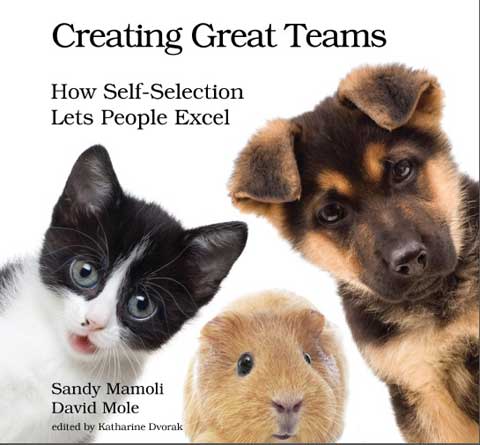Based on their experience with Trade Me, New Zealand’s largest e-commerce company, Sandy Mamoli and David Mole have written a complete guide on why and how you could implement a self-selection process for your teams. If you believe in self-organization for Agile project management teams, you should also think about self-selection.
The “Creating Great Teams” book provides a complete overview of the self-selection, from its definition to the results achieved. With the practical experience of Trade Me, you can follow a step by step journey on how a company implemented this self-selection process, how you can deal with the issues that this change creates and what benefits you might expect from such transformation. In each chapter, there is a balanced mix between the theoretical concepts behind self-selection and its actual practice. The book is short (90 pages), easy to read and full of checklists and other interesting tools for self-selection and project management.

Even if you don’t plan to implement a self-selection process tomorrow, I will recommend this book to every software development manager and project manager that want to have a different perspective on how their teams work and should be designed. Agile coaches and ScrumMaster will also particularly enjoy reading this book.
Reference: Creating Great Teams – How Self-Selection Lets People Excel, Sandy Mamoli and David Mole, The Pragmatic Bookshelf, IBSN 978-1-68050-128-5
Quotes
One reason for greater productivity in stable teams is that they don’t have to repeatedly go through the team-building stages of forming, storming, norming, performing over and over again. Constantly changing and churning teams (as you often get when assembling and disassembling specific project teams) may never get out of the initial forming stage, and they could forever stay a group of individuals, no matter how talented.
Experience has shown us that smaller squads work best. While smaller is usually better, two people is a pair and not really a team – so the minimum number is three. We have also experienced that teams larger than 10 become unwieldy, unproductive, and often form subgroups that can introduce conflict.
We have said previously that the only thing worse than managerial selection is a fake Self-Selection where people are led to believe they are in charge of their own destiny, only to find out that that wasn’t the case at all. It is important to stick to your guns and follow through on the principles on which you promised the event to your participants.
A key difference between Self Selection and Managerial Selection is that with Self Selection people understand why certain decisions or compromises have been made. Even if tough calls are required, people understand why and will have been involved in the decisions. When new squads are established via Self Selection, a very different environment emerges from one in which people question or misunderstand key decisions that have been made by managers above them. Self Selection might seem tiring, slow, or even frustrating at the time, but the process is as important as the outcome.
Since Self-Selection we have seen a significant rise in the number of user stories shipped to production. Our hypothesis that stable squads made up of people who had chosen to work together would be more productive proved to be true. The days of disbanding squads at the end of a project just as they were starting to work well together or disbanding them because we, as managers, had got the team composition wrong seemed a long way behind us.

